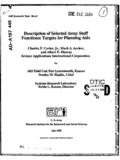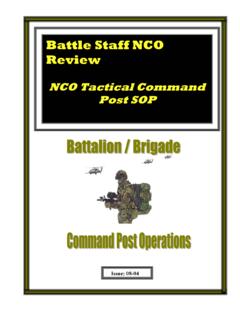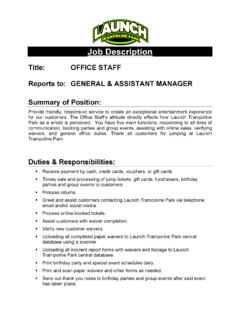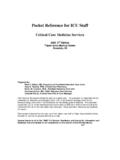Transcription of LVNR Staff Study
1 Grand Junction Police Department lvnr Staff Study An appropriate force option? Grand Junction Police Department Defensive Tactics Cadre 9/29/2010 Table of Contents Executive Summary 1 Types of Neck Restraints 3 GJPD Historical Perspective of Neck Restraints 5 Legal Opinions 8 Medical Research/ Opinion 10 Recommendations 14 Selected Bibliography 15 Appendices A. lvnr Agency Survey B. Agencies Trained in the lvnr 2007-2010 Executive Summary This document is designed to provide a framework to allow agency administrators to make an informed decision on whether to allow officers of the Grand Junction Police Department to continue to utilize the Lateral Vascular Neck Restraint as a force option.
2 The document in divided into 5 sections: what are neck restraints and why is the lvnr different from other forms of neck restraints, the history of neck restraints in the Grand Junction Police Department, legal findings regarding neck restraints, medical opinions regarding neck restraints, a survey of Colorado agencies regarding neck restraint usage and an appendix of law enforcement agencies that are certified to teach and utilize the lvnr . The Lateral Vascular Neck Restraint ( lvnr ) was approved for implementation as a force option at the Grand Junction Police Department in December of 2007. This approval was given on a trial basis, to determine if this force option was viable for the department. The initial 8 hours of training was conducted in November of 2008 and a Special Order regarding lvnr use was issued.
3 There were no uses of the lvnr in 2009. The yearly mandatory 4 hour retraining was conducted in January of 2010. As of August 10, 2010 there have been three successful uses of the lvnr to control resistive subjects. There were no injuries to officers or suspects during these three applications. All subjects complied before being rendered unconscious. Neck restraints can be divided into two main categories, vascular and respiratory. These types of control holds have been used in combat for thousands of years and more recently in sport, most notably Judo for over 100 years. With the current popularity of mixed martial arts many more people have been exposed to both forms of neck restraint. For law enforcement purposes a respiratory choke is usually banned by policy and is not taught.
4 However, a bar arm choke, a type of respiratory choke, is commonly used in the sport of Judo and mixed martial arts to control and submit opponents. Vascular neck restraints are designed to control subjects by limiting the flow of oxygenated blood to the brain causing unconsciousness. Vascular neck restraints by design do not restrict airflow into the lungs and do not cause choking. One dramatic difference with the Lateral Vascular Neck Restraint is that it is designed to control resistive individuals prior to the onset of unconsciousness. Resistive individuals are only taken to unconsciousness if they fail to comply with orders given at the lower level applications of the lvnr . Legal opinions regarding neck Medical research on the use of neck restraints can be divided into two categories.
5 An extensive amount of research has been conducted regarding neck restraints in the sport of Judo. This research consistently shows that there are no deleterious effects of Judo chokes. The second body of research has come mostly from coroners and pathologists. It is inconclusive and is somewhat limited. One of the major concerns with the second type of medical research regarding neck restraints is that only applications of neck restraints that have had an adverse outcome, such as severe injury or death have been examined. This does not take into account the hundreds of thousands of application of neck restraints that have occurred in a law enforcement setting that have had no adverse effects. Even when medical opinion is based on only on a few cases opinions vary to the safety of neck restraint.
6 Based on these studies there is no definitive medical opinion on the safety of neck restraints. It is the Defensive Tactics Cadre s recommendation to retain the lvnr as a force option in its current form. Many of the recommendations made by proponents of neck restraints, (mostly Judo and law enforcement practitioners) and detractors, (mainly pathologists and coroners) have been adopted by the National Law Enforcement Training Center in their guidelines for training, use and aftercare of the lvnr . The lvnr provides a force option that is similar to the Taser. Officers are able to control subjects quickly and with a reduced chance of injury to the officers and subject. Officer size and strength are not overriding factors in the successful use of the lvnr .
7 Finally, the lvnr has a proven track record. In hundreds of thousands of applications over a 40 year service life there have been no reported deaths or serious injuries or adverse litigation specific to the lvnr . Types of Neck Restraints Neck restraints have been used as a control technique in combat and sport for hundreds of years. The sport of Judo has utilized vascular and respiratory chokes for over 100 years with no reported deaths. There are basically two types of neck restraints, a vascular and a respiratory restraint. Vascular neck restraints are commonly referred to as the carotid hold, lateral vascular neck restraint, and bilateral neck restraint. Respiratory chokes are commonly referred to a bar arm choke or guillotine choke.
8 The difference between a respiratory choke and a vascular neck restraint are significant, both in mechanics and the method for gaining compliance. The respiratory choke is usually applied by directing pressure either from a body part or clothing to the front of the subject s trachea and larynx. This choke causes unconsciousness by depriving the lungs of oxygen. Additionally, this type of choke may cause compliance through the pain associated with the hold. Research and application in the mixed martial arts has shown that the trachea is actually much more robust than is popularly believed. It has been shown that the trachea can withstand at least 36 pounds of pressure before becoming compromised. Most law enforcement agencies in the United States prohibit the use of a respiratory choke.
9 The vascular neck restraint, to include the Lateral Vascular Neck Restraint focuses on compression of the carotid arteries on both sides of the neck. All law enforcement neck restraint systems configure the arms in order to protect the trachea and the airway. Carotid neck restraints are successful for a combination of physiological reasons. These include carotid artery occlusion, venous compression, carotid sinus/ vagus stimulation, and the valsalva maneuver. Carotid artery occlusion is the compression of the arteries to slow blood flow in and out of the brain. The carotid arteries supply approximately 70% of the blood to the brain. The carotid arteries are very resilient and it is not possible to completely stop the blood flow through these arteries with only pressure applied with the arms.
10 Parallel to the carotid arteries are the jugular veins. Veins push blood at a much lower pressure than arteries and are more easily compressed. The internal and external jugular veins connect to the Superior Vena Cava system which brings blood back to the right side of the heart. The venous compression impairs cranial circulation which alone can result in unconsciousness. Carotid sinus/ vagus stimulation occurs when the vagus nerve, which runs parallel to the common carotid artery, is stimulated due to the placement of the arms around the subject s neck. The stimulation of this nerves causes a slowing of the heart beat and drop in blood pressure. The valsalva maneuver pertains to pressurization of the chest cavity through holding ones breath and compression of the diaphragm.









![Links [www.usd375.org]](/cache/preview/1/f/6/8/1/a/0/f/thumb-1f681a0fa0d698fd290c516e84a26bac.jpg)